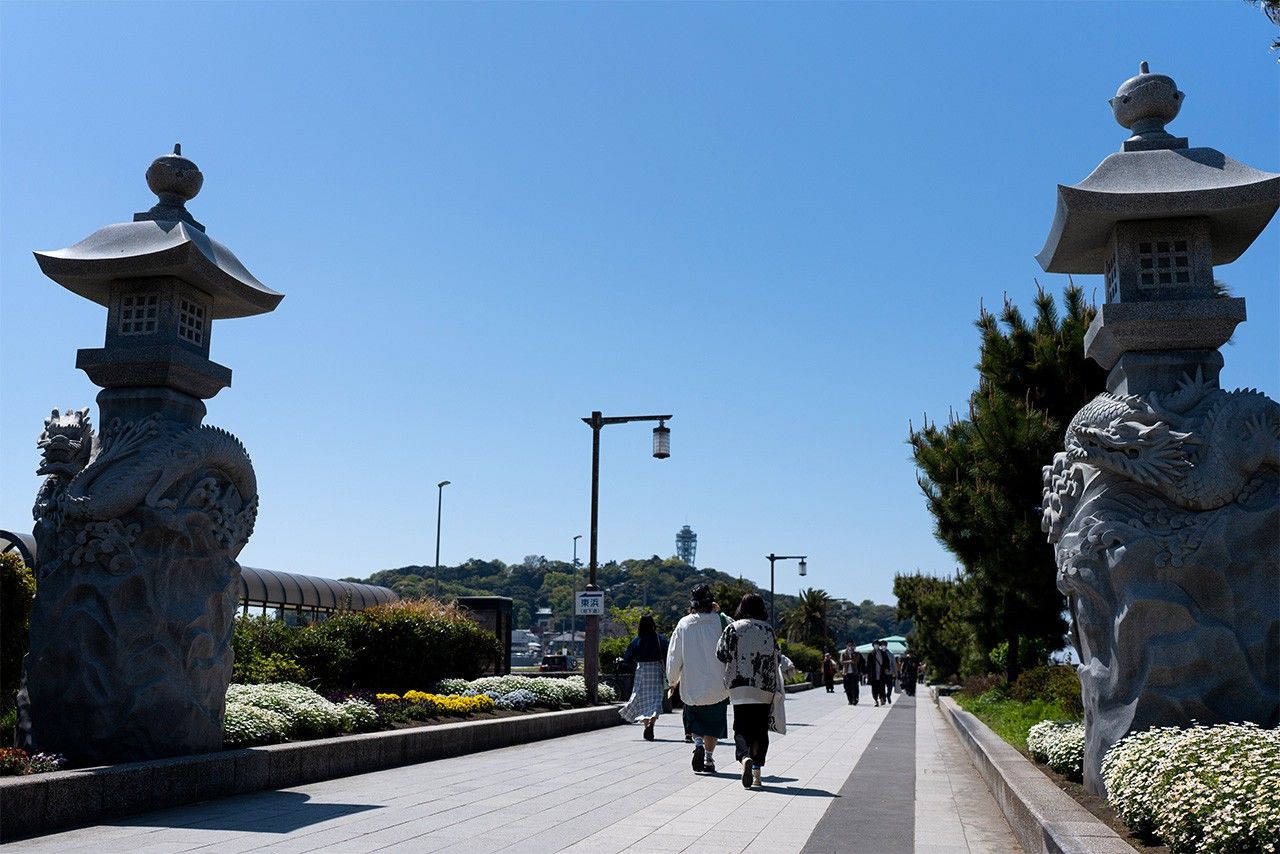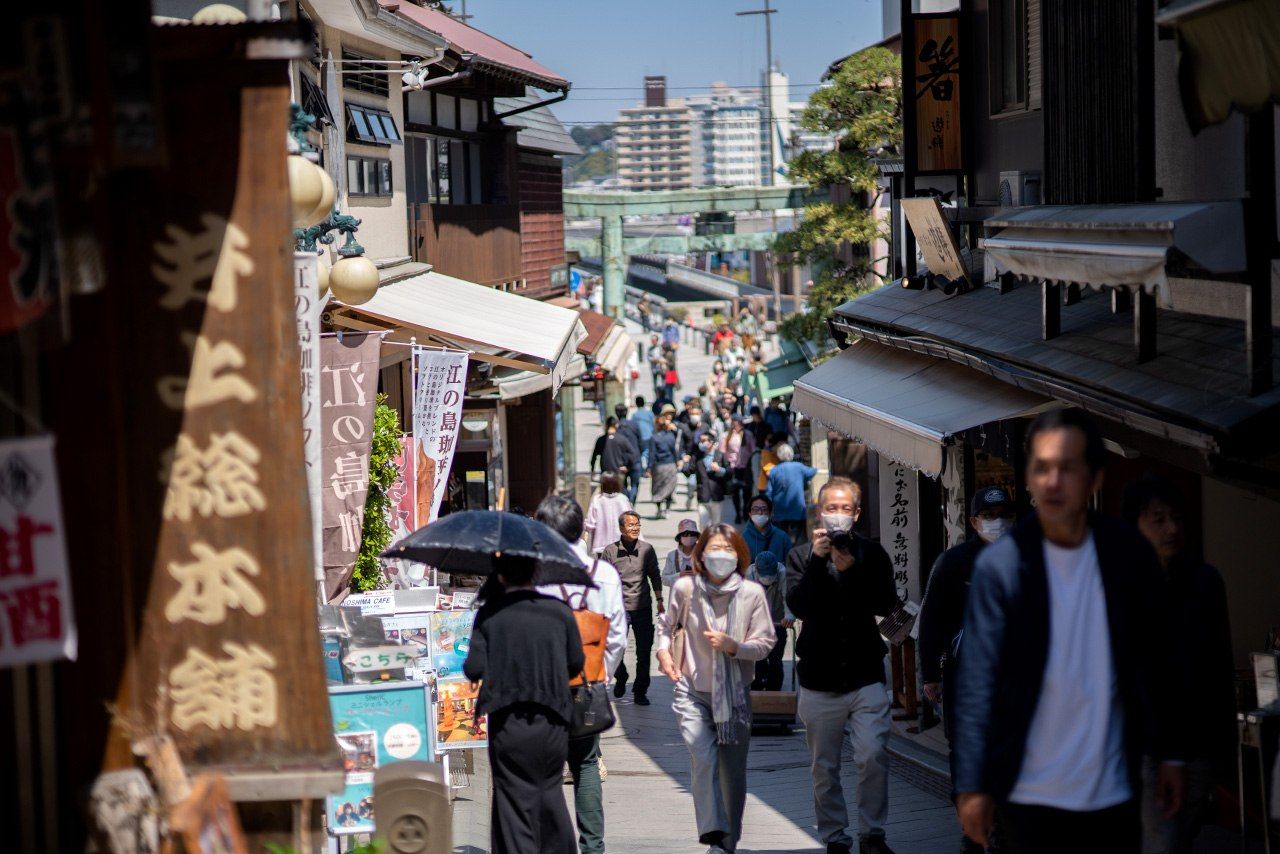
Japan’s Popular Tourist Destinations
Exploring the “Otaku Island” of Enoshima
Guide to Japan Travel Manga Anime Culture- English
- 日本語
- 简体字
- 繁體字
- Français
- Español
- العربية
- Русский
Located in the middle of Kanagawa Prefecture’s Shōnan region, Enoshima has been a scenic spot since ancient times. However, in the last 20 years, several manga and anime creators have set their stories among its winding lanes and steep slopes. This article will focus on three in particular: the 2012 fishing-themed manga Tsuritama, the 2012 anime series Tari Tari, and the 2002–5 Erufen rīto (Elfen Lied).
Our walk starts at Enoden Enoshima Station, whose mountain-cottage-looking building is shown in A channeru (A Channel, released as a manga in 2008, and an anime in 2011). In the fifth episode of that TV series, the main characters go on a trip to the beach facing the island, so we turn left at the station exit and follow their footsteps down Subana-dōri, the local shopping street. When you leave the station, don’t miss the metal fences in front of the ticket gate. They are decorated with small birds wearing colorful knitted hats and jackets that are changed every month or two.
Enoshima Benten Bridge
After about 10 minutes, we reach the sea. In the past, Enoshima was accessible on foot at low tide. Now, however, it can only be reached via the 389-meter Enoshima Benten Bridge, named after the deity who, according to legend, caused the island to rise from the bottom of the sea in the sixth century.

Pedestrians make their way across Benten Bridge, Enoshima. (© Benjamin Parks)
According to this colorful legend, Enoshima was born in 552, during the reign of Emperor Kinmei. At that time, an earthquake shook the earth for 10 days, and a pillar of fire rose from the sea floor, forming Enoshima. Then, a celestial maiden appeared and married a five-headed dragon.
Otaku fans will immediately recognize Benten Bridge and the island’s main street, Nakamise-dōri, for the scene in Tari Tari in which Wakana, one of the protagonists, commutes to school on her bicycle. The bridge has also been used as one of the key visuals in Tsuritama, while in Elfen Lied, it becomes the battleground for the duels between Mariko, Nana, and Lucy. It is the object of numerous attacks and sustains extensive damage, particularly in the anime version. On a brighter note, it is one of the places from which, on a clear day, we can enjoy a magnificent view of Mount Fuji.

A view from Enoshima Sea Candle, the observation tower on the island. (© Benjamin Parks)
We finally reach the island and are welcomed by the majestic green bronze torii gate marking the entrance to Enoshima’s shrine. Originally erected in 1747, it was rebuilt in 1821, and the names of the believers who donated money have been engraved on its pillars. This torii, by the way, appears in both the 2013–17 Himōto! Umaru-chan and the 2007–16 Shinryaku! Ika musume (Squid Girl).
Nakamise-dōri
Nakamise-dōri is always packed with tourists since it is lined with restaurants and shops. Indeed, the scene where Wakana rides her bike down the slope could only happen early in the morning, when the shops are still closed. This is also the neighborhood where one of the characters in Tsuritama lives and runs a store. If you venture into one of the narrow passages on the right side of the slope you will reach Nishiura Cove, a little-known spot featured in Tsuritama. But anime aside, the maze of alleys on both sides of the main shopping lane are well worth exploring and surprisingly tourist-free.

Nakamise-dōri and the island’s green bronze torii gate. (© Benjamin Parks)
Samuel Cocking Garden and Enoshima Sea Candle
Our next stop is the Samuel Cocking Garden, which owes its name to the London-born trader who in 1880 bought part of the island and two years later opened a botanical garden whose modern version can be visited to this day. In Tsuritama, this is the place where Kate, the grandmother of one of the boys, works.

A view from above of Samuel Cocking Garden. (© Benjamin Parks)
Inside the garden stands Enoshima Sea Candle, a large lighthouse that soars at the top of the island. Built in 2003 and 60 meters high, it features a glass-enclosed observation floor 120 meters above sea level and an outdoor deck, and is one of the largest civilian lighthouses in Japan.
After sunset, the illuminations turn the garden and lighthouse into a popular romantic spot. However, as Elfen Lied fans know well, some of the story’s darker and more climatic events occur here, particularly at the end of the manga version when the Sea Candle becomes the saga’s final battleground.

Sea Candle, Enoshima. (© Benjamin Parks)
With all its ups and downs, exploring Enoshima requires a certain dose of stamina, so let’s take a break at a couple of cafes that are featured in Tari Tari. The first one, Enomaru, has a retro nostalgic feel and a shop selling products such as postcards made from washi paper and other handicrafts. In Tari Tari‘s first episode, Konatsu and Sawa are seen here eating homemade banana cake, while in the third installment, Wakana has tea all by herself.

A walk on the island involved plenty of ups and downs. (© Benjamin Parks)
The second place, Aburaya, is an old Japanese-style café and sweets shop and is featured even more prominently in the story (where it is called Kokageya) because it happens to be Wakana’s family home. It is easy to spot because the characters are often drawn on a signboard strategically placed near the entrance. Its signature dish is shiratama zenzai (sweet azuki bean soup and rice flour dumplings) with matcha ice cream.

The sign marking Enoshima’s Aburaya café. (© Benjamin Parks)
Chigogafuchi Abyss
After descending another steep flight of stairs, we finally arrive at the back of the island and the rocky coast known as Chigogafuchi. This beautiful sea-eroded plateau was created by an uplift phenomenon during the Great Kanto Earthquake (1923) and is famous for the fierce waves that crash incessantly.

A view from the walkway at Chigogafuchi Abyss. (© Benjamin Parks)
It has been selected as one of Kanagawa Prefecture’s 50 scenic spots because from here one can see the island Izu Ōshima to the south and Mount Fuji, as well as the mountains of Hakone and Tanzawa, to the west. It is known as a popular spot for shore fishing, and at low tide, it swarms with people exploring all its nooks and crannies.
Just be careful where you put your feet. The rocks are often slippery, and some of the seemingly harmless pools of water can be upward of a meter deep. In Tari Tari, for instance, there is a scene in which Konatsu loses her footing and ends up in one such pool, just like the fish that regularly get trapped at low tide.
Also, because Chigogafuchi is almost at sea level, it is always a good idea to check the weather beforehand, and in case of a rough sea, steer clear of the rocks and enjoy the view from a safe distance.

The rocky coastline of Chigogafuchi. (© Benjamin Parks)
On the way back, a handy shortcut allows tired walkers to avoid all those steps. Turn right when you reach Okutsu Shrine, then take the first alley on the left. Follow that path and in a few minutes you will be back at Enoshima Shrine. Otherwise, if you visit on weekends or a holiday, you can go back by boat. It only costs ¥400 and it drops you off near the entrance of Enoshima Pier.

Enoshima Shrine. (© Benjamin Parks)
(Originally written in English. Banner photo: Viewing Enoshima from the beach at sunset. © Gianni Shimone.)
